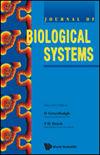全球稳定蛋白转录动力学的振荡模型
IF 1.5
4区 数学
Q3 BIOLOGY
引用次数: 0
摘要
振荡出现在生物组织的各个层次。振荡现象并不总是具有简单的周期性。在这项工作中,我们分析了一个基因转录网络,在这个网络中,我们假设一个几乎周期性的输入来调节基因。我们使用几乎周期性的输入[公式:见文本],因为周期性的输入是非常严格的。我们证明了所提出的概周期模型具有唯一的概周期吸引子。数值模拟结果表明,当上游系统与下游系统相互连接时,几乎周期性输入对系统的回溯性影响很大。通过对模型解的比较,我们可以得出结论,当结合到启动子上的蛋白质量用周期函数或几乎周期函数建模时,用[公式:见文]表示,蛋白质浓度[公式:见文]的量可以被低估或高估,这取决于[公式:见文]是用周期函数还是几乎周期函数建模。这些估计误差可能导致追溯性量化的误差,进而可能改变上游系统和下游系统之间的协调。本文章由计算机程序翻译,如有差异,请以英文原文为准。
AN OSCILLATORY MODEL FOR GLOBALLY STABLE PROTEIN TRANSCRIPTION DYNAMICS
Oscillations appear in all levels of biological organization. Oscillatory phenomena do not always possess a simple periodic nature. In this work, we analyze a gene transcriptional network in which we assume an almost periodic input that regulates gene. We use an almost periodic input [Formula: see text] since a periodic one is very restrictive. We show that the almost periodic model proposed has a unique almost periodic attractor. Numerical simulations show that the retroactivity is highly affected when an almost periodic input is used in an upstream system that is interconnected to a downstream system. By comparison of the solutions of the model, we can conclude that when the amount of protein bound to the promoter is modeled by either a periodic function or an almost periodic one, which is denoted by [Formula: see text], the amount of protein concentration [Formula: see text] can be underestimated or overestimated depending on if [Formula: see text] is modeling by a periodic or an almost periodic function. These estimation errors can lead to an error in the quantification of retroactivity which in turn can alter the coordination between an upstream system and a downstream one.
求助全文
通过发布文献求助,成功后即可免费获取论文全文。
去求助
来源期刊
CiteScore
2.80
自引率
12.50%
发文量
31
审稿时长
1 months
期刊介绍:
The Journal of Biological Systems is published quarterly. The goal of the Journal is to promote interdisciplinary approaches in Biology and in Medicine, and the study of biological situations with a variety of tools, including mathematical and general systems methods. The Journal solicits original research papers and survey articles in areas that include (but are not limited to):
Complex systems studies; isomorphies; nonlinear dynamics; entropy; mathematical tools and systems theories with applications in Biology and Medicine.
Interdisciplinary approaches in Biology and Medicine; transfer of methods from one discipline to another; integration of biological levels, from atomic to molecular, macromolecular, cellular, and organic levels; animal biology; plant biology.
Environmental studies; relationships between individuals, populations, communities and ecosystems; bioeconomics, management of renewable resources; hierarchy theory; integration of spatial and time scales.
Evolutionary biology; co-evolutions; genetics and evolution; branching processes and phyllotaxis.
Medical systems; physiology; cardiac modeling; computer models in Medicine; cancer research; epidemiology.
Numerical simulations and computations; numerical study and analysis of biological data.
Epistemology; history of science.
The journal will also publish book reviews.

 求助内容:
求助内容: 应助结果提醒方式:
应助结果提醒方式:


